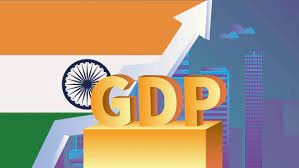India’s FY24 GDP Growth Projection at 7.3% as Per NSO Data
The National Statistical Office (NSO) recently unveiled its projection for India’s Gross Domestic Product (GDP) growth rate for the fiscal year 2024. According to the NSO data, India’s GDP is anticipated to grow at a rate of 7.3%, showcasing a promising trajectory for the country’s economic prospects in the upcoming year.
This projection has garnered significant attention across various sectors, especially among aspirants preparing for government exams, including roles in education, law enforcement, banking, railways, defense, and civil services like the PSCS to IAS.
The forecasted GDP growth rate of 7.3% for the fiscal year 2024 indicates a positive trend in India’s economic landscape. This information holds substantial importance for aspirants, providing insights into the potential economic environment they might encounter in their future professional roles.

Why this News is Important
Positive Implications for National Economy
The projection of a 7.3% GDP growth rate signifies a robust and optimistic outlook for India’s economic development. This holds vital importance for students aspiring to join government services, as a thriving economy often leads to enhanced employment opportunities and a conducive working environment.
Impact on Career Aspirations
For individuals aiming for various government positions, such as teachers, police officers, bankers, railway personnel, defense personnel, and civil servants, this projection hints at a buoyant job market. It serves as a motivating factor for aspirants, emphasizing the relevance of their chosen career paths in a flourishing economy.
Historical Context
India’s GDP growth rates have been pivotal in shaping the country’s economic narrative. In the past, fluctuations in GDP growth have influenced policy decisions and employment dynamics. Understanding historical patterns aids in comprehending the cyclical nature of economic growth and its impact on job markets and public sector recruitment.
Key Takeaways from “India’s FY24 GDP Growth Projection at 7.3%”:
| Serial Number | Key Takeaway |
|---|---|
| 1. | NSO projects India’s GDP to grow at 7.3% in fiscal year 2024. |
| 2. | Signifies a positive economic environment for aspiring government employees. |
| 3. | Provides optimism for increased job opportunities across sectors. |
| 4. | Historical context of GDP growth rates aids in understanding economic trends. |
| 5. | GDP growth projections often influence policy decisions and employment scenarios. |
Important FAQs for Students from this News
1. What is the significance of the NSO’s GDP projection for FY24?
- The NSO’s projection of a 7.3% GDP growth rate for FY24 indicates a positive economic outlook, which is crucial for aspirants preparing for government exams, as it suggests potential job opportunities in various sectors.
2. How does GDP growth influence career prospects in government roles?
- A higher GDP growth rate often correlates with increased job opportunities in sectors such as education, law enforcement, banking, railways, defense, and civil services, impacting the career prospects of exam aspirants.
3. Why is understanding historical GDP patterns important for aspirants?
- Historical GDP trends help in comprehending economic cycles, policy decisions, and their influence on employment dynamics, offering valuable insights for aspirants preparing for government exams.
4. How does a higher GDP growth rate contribute to the government’s revenue?
- A higher GDP growth rate often leads to increased tax revenue for the government. As the economy expands, businesses prosper, generating more income and consequently contributing higher tax revenues to the government coffers.
5. Can the GDP growth rate impact inflation in the country?
- Yes, a rapid increase in GDP growth might spur inflationary pressures in an economy. When the GDP grows too quickly, it may lead to increased demand for goods and services, potentially outpacing supply, thus causing prices to rise, a phenomenon known as demand-pull inflation.
Some Important Current Affairs Links


















